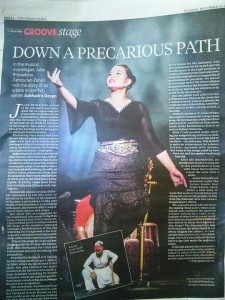JALAN Primadona proved not mere entertainment but an engrossing tale of unresolved conflicts in the contemporary Muslim world.
One was the issue of being a female artiste and yet to abide by the laws of the religion. The smaller one was that of the heritage performing arts, particularly that of Kelantan.
Presenting these issues was Zamzuriah Zahari using a musical monologue style that stretched for about two hours with a 15-minute intermission at the Kuala Lumpur Performing Arts Centre in Sentul, Jalan Ipoh.
Beginning with recollections as an older woman, now running a cafeteria, and having embraced religion, she recalled her start as an artiste and her glory days.
From mak yong to tari inai and mek mulung, she offered points where ethnocentricism was misplaced as there were similarities of these arts in the Southeast Asian region. Actually, some have their roots in India and China as well, but I digress.
Zamzuriah played several different characters to tell this story of an artiste in conflict, in the journey to become a primadona in the arts world.
From bystanders to gossiping colleagues, she showed off her vast talents as actor, dancer and singer.
Her show was accompanied by the traditional arts group Geng Wak Long, including her young son. The band had an interesting walk into the stage, as the members appeared through a backlit screen. It was like watching the background to the wayang kulit coming forward onto centrestage rather than remaining hidden.
Hence setting the stage for a layered performance, the 33-year-old Zamzuriah set about showing her trials and tribulations towards becoming this primadona.
Awarded the National Arts Awards for the young talent (dance) category in 2006, which she mentioned in her show, she also thanked her many teachers at the National Arts and Heritage Academy including Dr Joseph Gonzalez, whom she said had put forward many a student but has yet to see his own just recognition.
This monologue, based 60 per cent on Zamzuriah’s own experiences, saw her husband Baisah Hussin as the musical director. He also performed the silat with Zamzuriah, who went on to dance for the audience, who gave real money for her to pick up with flexible grace in the yogic position of Urdhva Dhanurasana (upward bow).
From this metaphorical suggestion of performing for payment, she moved to that stage in her life when religion beckoned whence she became a mother of three, leaving her children to be cared for by her parents.
But the public still called for her performances. This was the choice for a female artiste, with or without the religious aspect thrown in. A mother, wife and an artiste. On top of that, a Muslim.
While it seems as if Jalan Primadona may be Zamzuriah’s stage swansong, the production could have been enhanced by surtitles as Zam spoke much in the Kelantanese dialect as well as Bahasa Malaysia.
With 17 self-penned songs, showing her songwriting abilities as well, only one song stood out at the end of the show — the title song. This in itself is quite an achievement for a dance lecturer, currently with Aswara, but some of the songs could be have been cut and the spoken word used instead. After the intermission, the production tended to drag due to this proliferation of song with music that tended to sound the same after a while.
Jalan Primadona is presented under The Actors Studio Seni Teater Rakyat, which offers a wide body of work that seeks to “merakyatkan seni” (bring the arts to the people), in line with the National Arts and Culture Department’s efforts.
The segment of why one wears the tudung, where Zamzuriah asks audience members the question without waiting for a reply, to the laughter of others in the crowd, could have been accompanied by a video of this Sisters in Islam documentary, Aku Siapa? The documentary was to bring home the point that it is not about religion but culture, as Zamzuriah then pointed out when back in stage. One felt it was a lack of relevant knowledge that made the audience laugh.
At the end, as Zamzuriah as the artiste had no answers to offer to the conflicts raised in Jalan Primadona, it made for an interesting discussion as well as a fascinating theatrical show.


